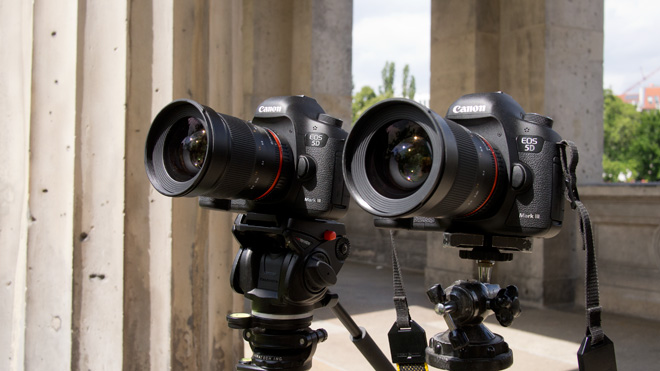
Introduction
Here are my preferred settings and picture profile for the 5D Mark III. These are general purpose settings – the ones I use most often for optimal out of the box results straight off the card, no grading required.
Standard  EOSHD settings
EOSHD settings
Picture profile
- Faithful
- Sharpness 0 (far left)
- Contrast 0 (middle)
- Saturation 0 (middle)
- Color tone 0 (middle)
Punchy  EOSHD settings
EOSHD settings
Picture profile
- Neutral
- Sharpness 0 (far left)
- Contrast +3
- Saturation +2
- Color tone +2
Sharpening in post recommendation
Apply the ‘Sharpen’ filter under Video Effects in Adobe Premiere Pro CS5.5 at between 30-50 to suit the shot
Menu settings
- SHOOT 4
- Movie rec. size: 1920 24/25p, ALL I
- SHOOT3
- High ISO speed NR – OFF
- Highlight tone priority (HTC, D+) – OFF
- SHOOT2
- Auto Lighting Optimiser – OFF
- C.Fn2 Disp./Operation
- In Custom Controls set the SET button to Mag/Reduce for your focus assist
White Balance
Use the Kelvin scale manual setting for best results.
Why do I use these settings?
The picture profile
The picture profile Faithful is typical Canon – a nicely warm image which is cinematic. Neutral is similarly cinematic but without the warmer hue. Portrait brings too much noise into the image, Landscape is too electronic looking. Technicolor CineStyle I find usually gives a compressed tonal range which leads to some ugliness of not handled carefully at the grading stage. Use Faithful or Neutral for great results out of the box and for convenience.
Sharpness, contrast, saturation and colour tone
Sharpness is turned off in-camera. It is important not to sharpen the image too much in-camera as it leads to ugly electronic looking footage which isn’t cinematic and rather eye fatiguing. There’s quite a difference between having sharpening off altogether and having it on low. On low this gives you more satisfying footage out of the camera and yet doesn’t compromise your ability to further sharpen the footage in post if you need to.
Contrast and saturation are baked into the codec because it isn’t a raw format, but H.264. If you turn these down it adds to your headache in post as the footage will always need grading. Colour data is reduced with saturation turned down. It is easier to desaturate something than to amplify something which isn’t really there in the first place. This goes for contrast as well.
Highlight Tone Priority / D+
Highlight Tone Priority or D+, shifts the 5D Mark III’s 10 stops of dynamic range in video mode toward the highlights and applies a slight boost to the lows to compensate for the shift. The highlight roll off on the 5D Mark III can be sudden. Usually I recommend to keep this off, but there may be some cases where enabling it benefits the image – i.e. where highlights are blown. Enabling this can increase noise and flatten colour a little.
Manual white balance
Auto-white balance can change in the middle of a shot. I usually also find it too cool for my preferences especially in strong sunlight and prefer the warmer Canon look of old. With manual white balance you can make a decision at the time of shooting to get the white balance right. Fixing this in post is a nightmare unless you have a raw video codec, which the 5D Mark III does not.
Auto Lighting Optimiser
This can override manual control of exposure so always disable it.
Custom Controls in the C.Fn2 menu
The magnify assists is an important button for manual focus in movie mode, however it is in an awkward place on the left side of the camera. This moves focus assist to the more prominent SET key near your thumb on the shutter release side of the camera.


